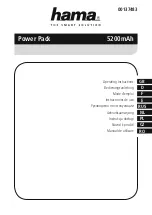
17
en
Wear personal protective equipment. Depending on
application, use face shield, safety goggles or safety
glasses. Where appropriate, wear dust mask, hearing
protectors, gloves and workshop apron capable of stop-
ping small abrasive or workpiece fragments.
The eye
protection must be capable of stopping flying debris
generated by various operations. The dust mask or res-
pirator must be capable of filtrating particles generated
by your operation. Prolonged exposure to high inten-
sity noise may cause hearing loss.
Do not direct the power tool against yourself, other per-
sons or animals.
Danger of injury from sharp or hot
application tools.
Do not rivet or screw any name-plates or signs onto the
power tool.
If the insulation is damaged, protection
against an electric shock will be ineffective. Adhesive
labels are recommended.
Clean the ventilation openings on the power tool at reg-
ular intervals using non-metal tools.
The blower of the
motor draws dust into the housing. An excessive accu-
mulation of metallic dust can cause an electrical hazard.
Use and handling of the battery (battery pack).
To avoid hazardous situations such as burns, fire,
explosion, skin injuries, and other injuries when han-
dling the battery, observe the following instructions:
Batteries must not be disassembled, opened or reduced
in size. Do not subject batteries to mechanical impact
or shock.
Hazardous vapours and fluid can escape in
case of damage and improper use of the battery. The
vapours can irritate the respiratory system. Liquid
ejected from the battery may cause skin irritations or
burns.
When battery fluid from a damaged battery has come
into contact with objects close by, check the respective
components, clean them or replace them as required.
Keep the battery away from heat and fire. Do not store
the battery in direct sunlight.
Do not remove the battery from its original packaging
until it is going to be used.
Before any work on the machine itself, remove the bat-
tery from the power tool.
If the power tool accidentally
starts, there is danger of injury.
Remove the battery only when the power tool is
switched off.
Keep the battery away from children.
Keep the battery clean and protect it against moisture
and water.
Clean contaminated battery terminals and
power tool connections with a dry, clean cloth.
Use only intact original FEIN batteries that are intended
for your power tool.
When working with and charging
incorrect, damaged, repaired or reconditioned batter-
ies, imitations or other brands, there is danger of fire
and/or explosion.
Follow the safety warnings in the operating instructions
of the battery charger.
Handling hazardous dusts
For work procedures with this power tool where
material is removed, dusts develop that can be hazard-
ous to one’s health.
Contact with or inhaling some dust types, e. g. asbestos
and asbestos-containing materials, lead-containing coat-
ings, metal, some wood types, minerals, silicate parti-
cles from materials containing stone, paint solvents,
wood preservatives, antifouling paints for vessels, can
trigger allergic reactions to the operator or bystanders
and/or lead to respiratory infections, cancer, birth
defects or other reproductive harm. The risk from
inhaling dusts depends on the exposition. Use dust
extraction matched appropriately for the developing
dust, as well as personal protective equipment and pro-
vide for good ventilation of the workplace. Leave the
processing of asbestos-containing materials to special-
ists.
Wood and light-metal dust, hot mixtures of grinding
dust and chemical materials can self-ignite under unfa-
vourable conditions or cause an explosion. Avoid
sparking in the direction of the dust collector as well as
overheating of the power tool and the materials being
sanded, empty the dust collector/container in time,
observe the material manufacturer’s working instruc-
tions, as well as the relevant regulations in your country
for the materials being worked.
Hand/arm vibrations
The vibration emission level given in this information
sheet has been measured in accordance with a stand-
ardised test given in EN 62841 and may be used to
compare one tool with another. It may be used for a
preliminary assessment of exposure.
The declared vibration emission level represents the
main applications of the tool. However, if the tool is
used for different applications, with different accesso-
ries or poorly maintained, the vibration emission may
differ. This may significantly increase the exposure level
over the total working period.
An estimation of the level of exposure to vibration
should also take into account the times when the tool
is switched off or when it is running but not actually
doing the job. This may significantly reduce the expo-
sure level over the total working period.
Identify additional safety measures to protect the oper-
ator from the effects of vibration such as: maintain the
tool and the accessories, keep the hands warm, organi-
sation of work patterns.
Emission values for vibration
Vibration
Classification of FEIN application
tools according to vibration class
Weighted
acceleration*
VC0
< 2,5 m/s
2
VC1
< 5 m/s
2
VC2
< 7 m/s
2
VC3
< 10 m/s
2
* These values are based on a work cycle consisting of no-load
and full-load operation of the same duration.
For information on the vibration class assigned to the applica-
tion tool, please see the enclosed data sheet 3 41 30 213 06 2.
OBJ_BUCH-0000000362-001.book Page 17 Wednesday, January 30, 2019 2:29 PM
















































